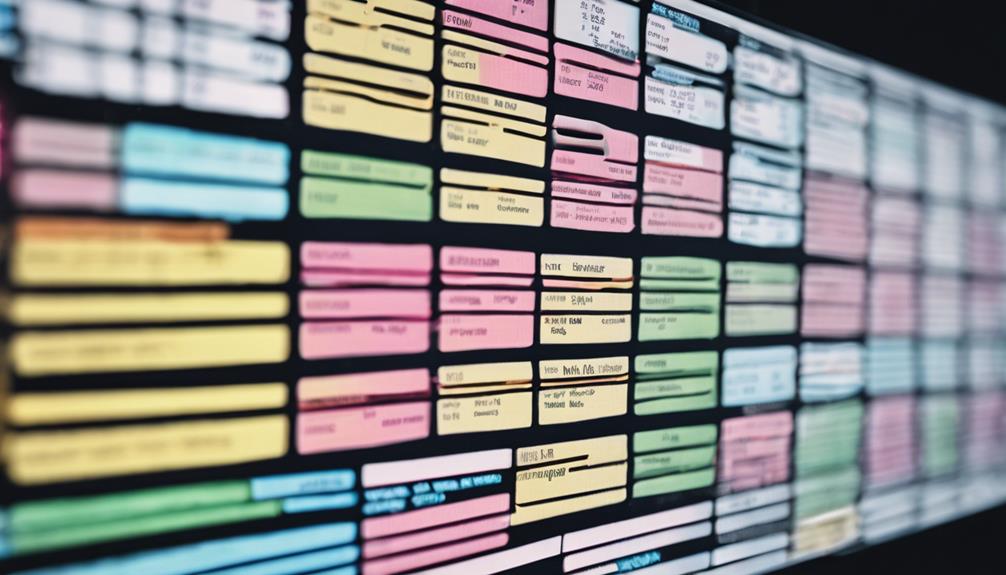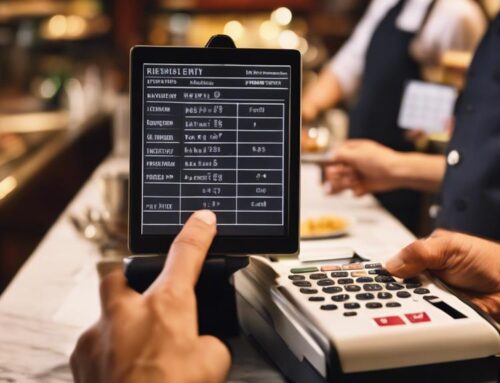To ensure consistency in restaurant menu data entry, standardize the format, categorize logically, and use numbering. Update menus promptly, review details regularly, and proofread meticulously to maintain accuracy. Double-check prices, ingredients, and categorization, then correct errors promptly. Train staff, use automation tools, and implement quality control for efficiency. Validate data, conduct quality assurance, and cross-reference information. Consistently maintain accuracy with systematic checks and audits. Attention to detail is key for a professional appearance and optimal customer experience. Stay organized, accurate, and systematic for successful data entry in restaurant menus. You’ll ensure efficiency and accuracy for your menu data.
Standardized Format
To maintain consistency in restaurant menu data entry, ensure that all items are inputted in a standardized format, facilitating efficient organization and accessibility for both staff and customers. Start by implementing data validation procedures to ensure that the information entered is accurate and complete. This step is crucial in guaranteeing that the menu is error-free and up to date.
When focusing on menu organization, consider categorizing items logically to make navigation easier for both employees and patrons. Group similar dishes together under clear headings, such as appetizers, entrees, and desserts. Additionally, utilize numbering or bullet points to list items in a structured manner, aiding in readability and comprehension.
Regular Updates
Ensure that regular updates to the restaurant menu are scheduled and executed promptly to maintain accuracy and relevance for customers and staff alike. Keeping menu item descriptions up to date is crucial to reflect any changes in recipes or offerings accurately. When updating the menu, ensure that ingredient sourcing information is also revised to align with any changes in suppliers or seasonal availability. Regularly reviewing and updating these details not only ensures that customers are provided with the most current information but also helps staff members stay informed and knowledgeable about the menu offerings. By staying proactive in updating menu descriptions and ingredient sources, you can prevent confusion among customers and maintain consistency in the dining experience. Set a schedule for menu updates, considering factors like seasonal changes, supplier variations, and customer feedback to ensure that the menu remains accurate and reflective of your restaurant’s offerings.
Proofreading
When proofreading restaurant menu data, be meticulous in checking for spelling and grammar errors to maintain a professional appearance. Ensure data accuracy by cross-referencing prices, ingredients, and descriptions, eliminating any discrepancies. Consistency in formatting helps create a seamless experience for customers navigating the menu.
Spelling and Grammar
Maintain meticulous attention to detail when proofreading restaurant menus to ensure consistency in spelling and grammar. When it comes to checking for spelling and grammar errors in menu data entry, remember the following:
- Language Proficiency: Ensure that the proofreader has a good command of the language in which the menu is written to accurately spot mistakes.
- Quality Assurance: Implement a quality control process to double-check all text for errors before finalizing the menu.
- Consistency Check: Compare similar items across the menu to guarantee uniformity in spelling and grammar usage.
Data Accuracy Check
To ensure the accuracy of data in restaurant menus, meticulously proofread for any errors in item descriptions, prices, and ingredients. Data validation is crucial in ensuring that the menu reflects the correct information. Check each menu item for accuracy assurance by verifying prices against the menu database. Ensure menu item categorization is consistent and accurate to avoid confusion for customers. Double-check content like ingredients to prevent any discrepancies that could lead to customer dissatisfaction. By conducting a thorough data accuracy check, you can guarantee that the menu is not only error-free but also provides reliable information to diners. Attention to detail in menu content verification is key to maintaining a professional and trustworthy image for your restaurant.
Consistency in Formatting
Ensure that every aspect of your restaurant menu, from item names to pricing details, follows a consistent and error-free format through meticulous proofreading. Consistency in formatting is crucial for maintaining a professional image and enhancing the overall customer experience. To achieve this, pay attention to the following key areas:
- Menu item categorization: Organize your menu items into clear categories such as appetizers, entrees, and desserts to make it easier for customers to navigate.
- Font size consistency: Maintain uniformity in font sizes throughout the menu to ensure a visually appealing layout and easy readability.
- Pricing details alignment: Double-check that all prices are aligned correctly to maintain a clean and organized look.
Double-Checking
Check and recheck all restaurant menu data entries to ensure accuracy and consistency. Quality control is paramount when it comes to maintaining data consistency across your menu. Implement a systematic approach to double-checking all data entered. Start by verifying the menu item names, descriptions, prices, and any other relevant information. Ensure that the format aligns with the established standards and guidelines.
Cross-reference the data with the original source to catch any discrepancies that may have occurred during entry. Pay close attention to numbers, ensuring that prices are accurate and that there are no typos or omissions. Double-checking also involves confirming that the categorization of menu items is correct and consistent throughout. Any changes made during the data entry process should be reviewed meticulously to prevent errors from slipping through the cracks.
Develop a checklist or standardized procedure for double-checking menu data entries. By incorporating this step into your data entry process, you can significantly reduce the likelihood of inconsistencies and inaccuracies making their way onto your menu.
Training Staff
To streamline your restaurant menu data entry process and ensure consistency, consider implementing a comprehensive staff training program that focuses on data accuracy and standards adherence. Training your staff effectively is crucial for maintaining consistency in menu data entry. Here are some key points to consider:
- Staff Communication: Encourage open communication channels among your team members to discuss any uncertainties or questions related to data entry. Clear communication can help in clarifying expectations and standards.
- Consistency: Emphasize the importance of following established protocols and guidelines consistently. Consistency in data entry practices will lead to uniformity in menu information across all platforms.
- Training Reinforcement and Accountability: Regularly reinforce training materials and provide ongoing support to ensure that staff members are consistently applying what they have learned. Establishing accountability measures can also help in maintaining data accuracy and adherence to standards.
Utilizing Automation Tools
Consider integrating automation tools into your restaurant menu data entry process to enhance efficiency and accuracy. Automation integration can streamline the data entry process by automatically inputting information, reducing the likelihood of human error. These tools can help ensure consistency in your menu data by enforcing standardized formatting and data validation checks.
When utilizing automation tools, it is crucial to select software that aligns with your specific menu data entry needs. Look for features such as customizable templates, auto-population fields, and real-time syncing capabilities to maintain accurate and up-to-date menu information across all platforms.
Data validation plays a vital role in maintaining the integrity of your menu data. Automation tools can help validate data entries by flagging inconsistencies or errors, allowing you to promptly address and rectify any issues. By incorporating these tools into your data entry workflow, you can improve efficiency, accuracy, and overall consistency in managing your restaurant menu.
Implementing Quality Control
To ensure accuracy in restaurant menu data entry, implementing quality control measures is crucial. This involves conducting data entry verification to confirm the information entered is correct and establishing an error correction process to rectify any mistakes promptly. By adhering to these quality control practices, you can maintain consistency in your menu data and provide customers with reliable information.
Data Entry Verification
Implementing a rigorous quality control process is essential for ensuring accuracy in restaurant menu data entry. When it comes to data entry verification, attention to detail is crucial. Here are some key steps to consider:
- Data Validation: Check for accuracy and completeness in the entered data.
- Quality Assurance: Ensure that the data meets the established standards and guidelines.
- Cross-Referencing: Verify the entered data with the original source to eliminate errors and inconsistencies.
Error Correction Process
To maintain accuracy in restaurant menu data entry, the error correction process serves as a vital component of implementing quality control measures. Error prevention is key to ensuring quality assurance in menu data entry. Consistency maintenance and data integrity rely heavily on a robust error correction process. When errors are identified, it is crucial to address them promptly to uphold the integrity of the data. Implementing systematic checks and balances can help in catching and rectifying mistakes efficiently. Regular audits and reviews play a significant role in identifying discrepancies and ensuring that the data is error-free. By emphasizing the importance of error correction and prevention, restaurants can uphold the accuracy and reliability of their menu data, ultimately enhancing customer satisfaction.
Frequently Asked Questions
How Can Restaurants Ensure That Menu Data Entry Is Consistent Across Multiple Locations or Franchises?
Imagine each location as a note in a symphony. Harmonize the data entry process like a skilled conductor. Utilize clear guidelines, training, and regular audits to prevent errors. Ensure a consistent menu melody across all franchise locations.
What Steps Can Be Taken to Prevent Errors in Menu Data Entry Caused by Human Error?
To prevent errors in menu data entry caused by human error, ensure data validation and quality control processes in place. Train staff rigorously on accurate data entry. Consider automation tools for efficiency and accuracy checks.
Are There Any Specific Tools or Software Programs That Can Help Streamline the Menu Data Entry Process?
To streamline menu data entry, utilize data validation tools for accuracy measures. Automate data entry for efficiency. Categorize menu items systematically. Utilize software programs tailored for restaurant menus. These tools enhance consistency and reduce errors in menu data management.
How Can Restaurants Ensure That Menu Data Entry Accurately Reflects Any Seasonal or Special Menu Items?
To ensure menu accuracy for seasonal promotions and special menu items, verify data consistency regularly. Implement a structured process for entry and review. Monitor changes closely to catch discrepancies. Maintain accurate records for seamless menu updates.
What Measures Can Be Put in Place to Ensure That Menu Data Entry Is Compliant With Any Industry Regulations or Standards?
To ensure menu data entry complies with industry standards, implement data validation for accuracy. Utilize quality control measures for consistency. Monitor compliance regularly and establish standardization practices. By adhering to these guidelines, maintain precision and reliability in your restaurant’s menu data entry process.




